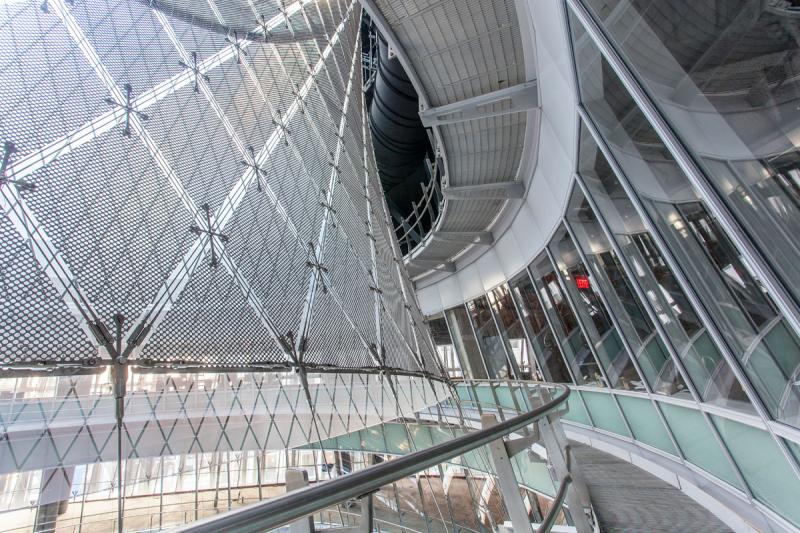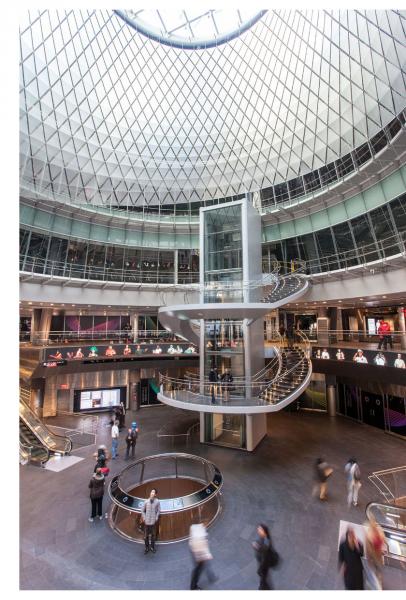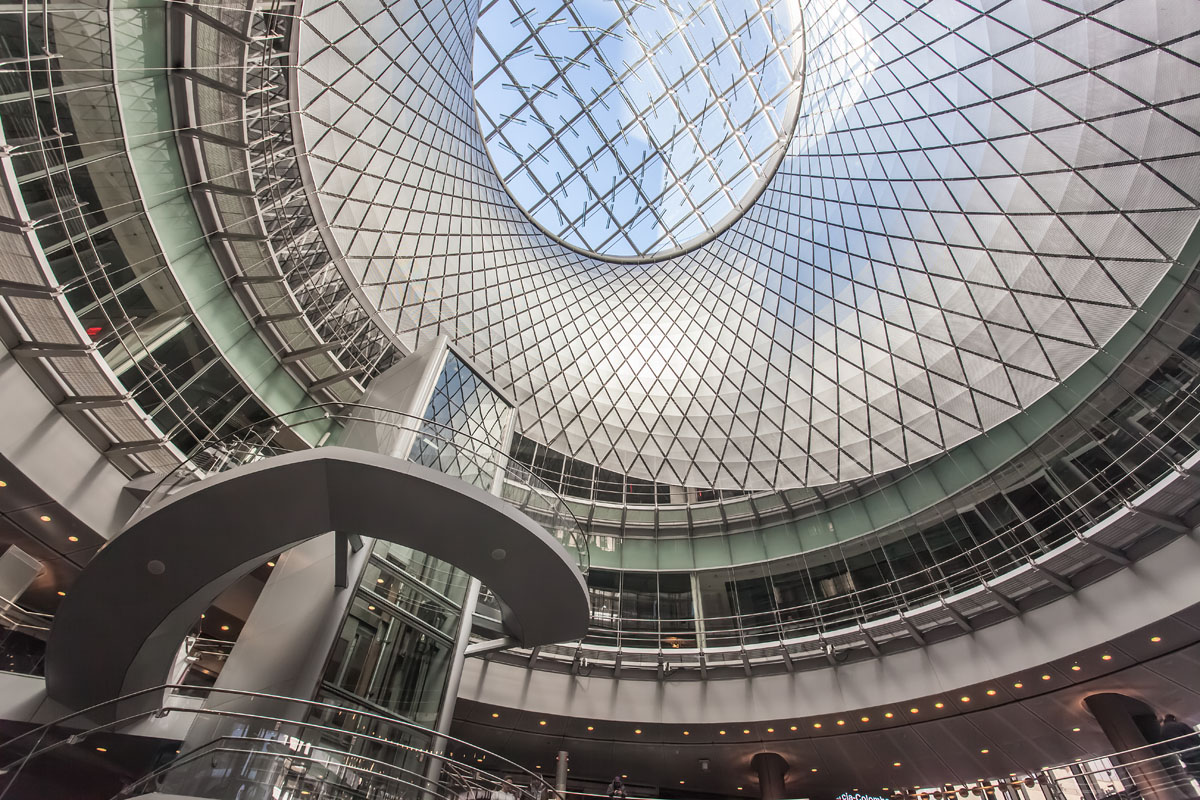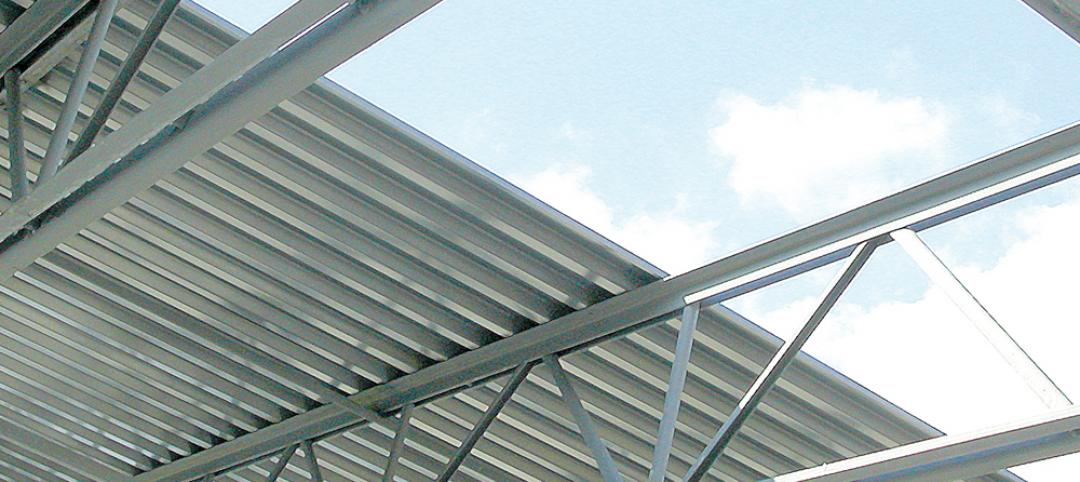When New York City was planning one of the first subways in the U.S. in the 1800s, a very real challenge was convincing people that going underground would be safe and pleasant. If those subterranean-fearing Victorian era Gothamites could see Manhattan’s Fulton Center transit hub opened in late 2014, they would be amazed at the light-filled, wide open space. In describing the Fulton Center, commuter Dave Palmieri told the New York Daily News, “The light pouring in is just incredible. It’s a real modern gem. Spatially, it’s like Grand Central.”
Located in the Lower Manhattan Financial District, the 180,000 square feet (16,700 square meters) Fulton Center integrates five subway stations served by nine subway lines, and includes retail and office space. The Metropolitan Transportation Authority predicts the center will serve as many as 300,000 transit riders daily.

Fire-rated curtain wall matches the non-rated system.
A defining visual feature of the Fulton Center is a 53 feet (16 meter) diameter glass oculus (Latin for “eye”) that streams light into a grand atrium. Beneath the oculus is the “Sky Reflector Net,” an artwork by James Carpenter Design Associates, Grimshaw Architects and Arup with 952 perforated aluminum panels that transmit sunlight 110 feet (34 meters) down into the Fulton Center’s lowest levels.
Within the grand atrium is a two-level circular enclosed space that will house restaurants and retail. Matching the curve of the oculus, some members of the project team affectionately call this space the “doughnut.” To keep with the light-filled aesthetic of the rest of the Fulton Center, the designers wanted this space to be glazed to allow in light from the oculus and Sky Reflector Net.
Designing and installing the glazed curtain walls for the doughnut required overcoming several complexities. In addition to its curved form, the doughnut’s walls also slant upward to match the angle of the oculus, which creates an inverted plane. To successfully achieve this design, Technical Glass Products (TGP) worked with the project team to develop custom captured horizontal steel mullions that fit the distinctive shape, for a flush and plumb surface appearance, with adequate spacing between each curtain wall segment.
Another challenge of the project was matching the aesthetics of the fire-rated curtain walls on the doughnut’s upper level and in a prominent elevator core with the non-fire-rated curtain wall system on the doughnut’s lower level. To achieve a seamless aesthetic, the designers chose TGP’s matched curtain wall systems.

To create matching curtain walls in the Fulton Center, TGP used steel framing members. Steel frames can be formed from tubes, instead of sheets, and shaped in an extrusion-like process that allows for a wide range of narrow mullion profiles. Because the same manufacturing method can be applied to fire-rated frames using steel back members, it was possible for the fire-rated curtain wall (Fireframes Curtainwall Series frames) to match the slender frame profiles of the non-rated system (SteelBuilt Curtainwall System).
"Because the interior spaces are flooded with light, a crucial part of the design aesthetic was glazed curtain walls with clean sightlines," said Andrew Anderson, associate principal, Grimshaw Architects. "That's easy enough to achieve with non-rated curtain wall assemblies, yet TGP's fire-rated curtain walls provide the same crisp, modern look. Their technical expertise and service enabled us to achieve a matching look across the curtain wall assemblies."
Further maintaining the uniform appearance between the two systems, TGP worked with the design team to develop fire-rated insulated glass units (IGUs) using Pilkington Pyrostop glass with the same decorative custom frit pattern used on the non-fire-rated glass.
This project also had the logistical challenge of delivering materials at the right time and in the right way to the crowded Lower Manhattan building site that has experienced vast redevelopment following the September 11, 2001, terrorist attacks. Tight coordination between TGP and the project team partners was crucial for successful curtain wall completions.
For more information on the Fireframes Curtainwall System and Pilkington Pyrostop, along with TGP’s other fire-rated glass and framing, visit www.fireglass.com. For more information on SteelBuilt Curtainwall System, along with TGP’s other specialty architectural glass and framing, visit www.tgpamerica.com.
Project Overview:
Project: Fulton Center Transit Hub
Location: New York City
Architect: Grimshaw Architects
Glazing Contractor: Enclos
Product: Fireframes® Curtainwall Series frames, Pilkington Pyrostop® glass and SteelBuilt Curtainwall® System
Contact Information:
Technical Glass Products
800.426.0279
800.451.9857 – fax
sales@fireglass.com
www.fireglass.com
Related Stories
| May 1, 2014
Super BIM: 7 award-winning BIM/VDC-driven projects
Thom Mayne's Perot Museum of Nature and Science and Anaheim's new intermodal center are among the 2014 AIA TAP BIM Award winners.
| Apr 29, 2014
USGBC launches real-time green building data dashboard
The online data visualization resource highlights green building data for each state and Washington, D.C.
Smart Buildings | Apr 28, 2014
Cities Alive: Arup report examines latest trends in urban green spaces
From vertical farming to glowing trees (yes, glowing trees), Arup engineers imagine the future of green infrastructure in cities across the world.
| Apr 9, 2014
Steel decks: 11 tips for their proper use | BD+C
Building Teams have been using steel decks with proven success for 75 years. Building Design+Construction consulted with technical experts from the Steel Deck Institute and the deck manufacturing industry for their advice on how best to use steel decking.
| Apr 2, 2014
8 tips for avoiding thermal bridges in window applications
Aligning thermal breaks and applying air barriers are among the top design and installation tricks recommended by building enclosure experts.
| Mar 26, 2014
Free transit for everyone! Then again, maybe not
An interesting experiment is taking place in Tallinn, the capital of Estonia, where, for the last year or so, its 430,000 residents have been able to ride the city’s transit lines practically for free. City officials hope to pump up ridership by 20%, cut carbon emissions, and give low-income Tallinnites greater access to job opportunities. But is it working?
| Mar 26, 2014
Callison launches sustainable design tool with 84 proven strategies
Hybrid ventilation, nighttime cooling, and fuel cell technology are among the dozens of sustainable design techniques profiled by Callison on its new website, Matrix.Callison.com.
| Mar 20, 2014
Common EIFS failures, and how to prevent them
Poor workmanship, impact damage, building movement, and incompatible or unsound substrate are among the major culprits of EIFS problems.
| Mar 19, 2014
Frames: the biggest value engineering tip
In every aspect of a metal building, you can tweak the cost by adjusting the finish, panel thickness, and panel profile. These changes might make a few percentage points difference in the cost. Change the framing and you have the opportunity to affect 10-20 percent savings to the metal building portion of the project.
| Mar 12, 2014
14 new ideas for doors and door hardware
From a high-tech classroom lockdown system to an impact-resistant wide-stile door line, BD+C editors present a collection of door and door hardware innovations.

















